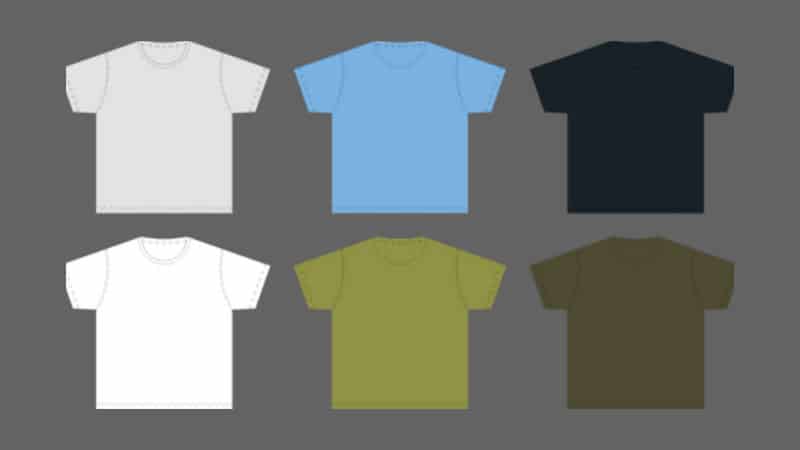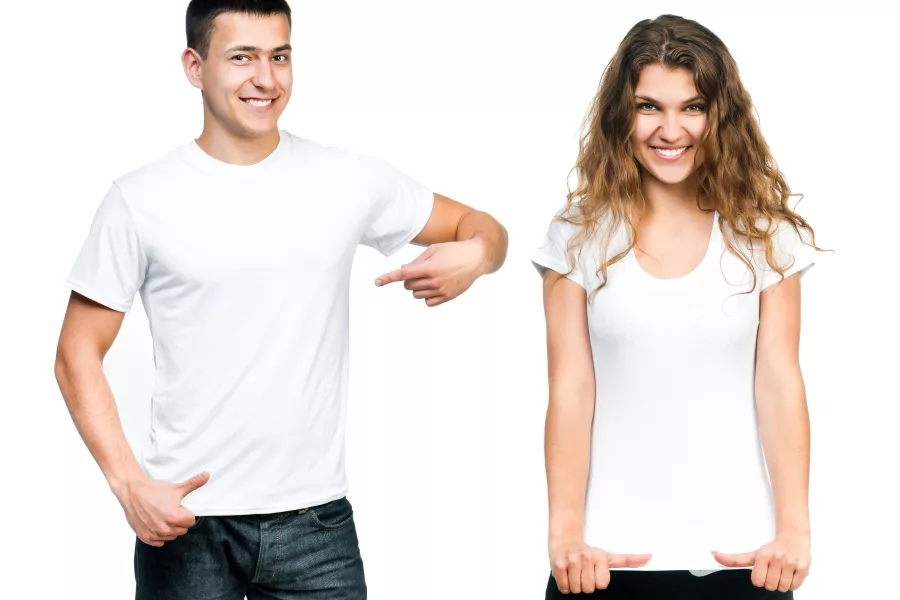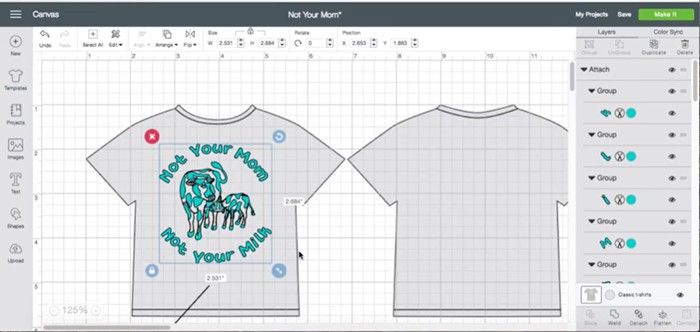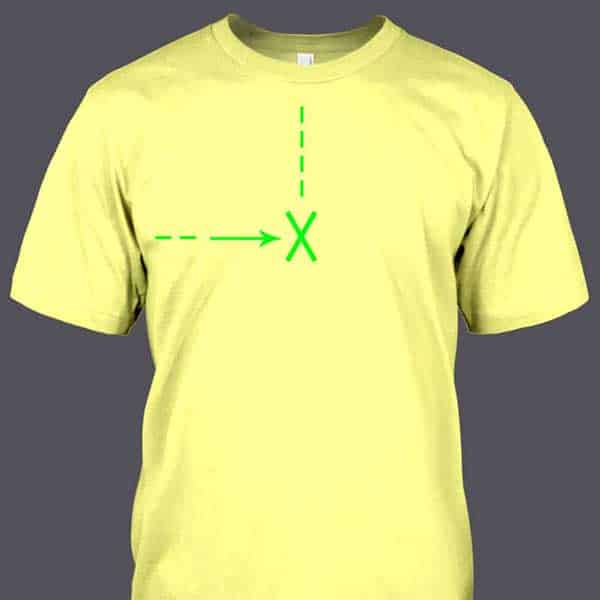HTV Size Chart: What You Need for Shirts and Other Things
by Alice Davis
If it's your first time using heat transfer vinyl, it's easy to get confused about the right size of vinyl to use to transfer your design to t-shirts and other items.
That said, choosing the right size of HTV is crucial when customizing your tees. If you use a design that's too small or too big, you'll end up with unprofessional results.
The following guide will help you take the guesswork out of iron-on vinyl sizing by showing you the right size to use for various items.
Contents

Why Sizing HTV is Crucial?

As we have just stated above, you'll need to ensure you choose the right size of heat transfer vinyl when customizing your t-shirts.
This will help ensure you get professional results, whether you're doing it as a hobby or for your clients.
What happens if you use a vinyl piece that's too small? Well, in this case, you'll end up making a small design with your vinyl cutter. And when you finally apply it on the t-shirt, it'll look unprofessional. Sorry to break it to you…but such a design will not even make your tees look appealing in any way.

And if you use an oversized piece of vinyl for your substrate? This will mean cutting a larger design than what would perfectly fit on your substrate. When you wear a t-shirt or any other garment with too big design, it might make an impression that you bought the wrong size of the cloth.
For business owners, using the wrong size of HTV is a sure way to frustrate your clients and send them away.
It doesn't matter if you're using the latest vinyl cutting machine or the best heat press for home use, incorrect sizing will always yield unprofessional results.
If you want to get the most appealing results when customizing various items with iron-on vinyl, take time to understand the right size of vinyl to use. The proper size will translate to a design that perfectly fits in place (on the substrate surface) and brings out the desired results.
What's The Right Size of Vinyl To Use?
Now that you understand why it's important to use the right size of iron-on vinyl, the next thing you want to know is the right size of vinyl to use for your projects.
The RIGHT size of HTV to use simply depends on the size of the garment you're transferring the design onto. For instance, a t-shirt meant for an adult, say an XL or XXL size, will require a bigger HTV than that worn by a kid. Likewise, you'll need a smaller design for baby cloth such as the onesie.
To make it easier for you to determine the right size of vinyl to use, see our complete HTV sizing guide below…
Heat Transfer Vinyl Sizing Chart
| Size of Shirt | Size of HTV to use |
| Baby onesie (0-6 months old) | 3 x 3 inch |
| Baby onesie (9-18 months old) | 4 x 4 inch |
| Toddler (2T-3T) | 5 x 4 inch |
| Toddler (4T-5T) | 6 x 6 inch |
| Youth (XS-S) | 6.5 x 6.5 inch |
| Youth (M-L) | 7 x 7 inch |
| Youth (XL) | 7.5 x 7.5 inch |
| Adult fitted (XS-L) | 9 x 9 inch |
| Adult fitted (XL) | 10 x 10 inch |
| Adult standard fit (XS) | 9 x 9 inch |
| Adult standard fit (S-M) | 10 x 10 inch |
| Adult standard fit (L-XL) | 11 x 11 inch |
| Adult standard fit (XXL) | 12 x 12 inch |
| Pocket design | 4×4 inch |
| Down the sleeve | 2.5 x 14 inch or 2 x 11 inch |
| On the hat | 4.75 x 2.75 inch |
| Adult hoodie | 12 x 16 inch |
Correct HTV Placement

Apart from getting the right size of design for various garments, you should also get it right when it comes to placing the design on your item.
This will help you avoid getting crooked, unprofessional results. Moreover, the correct placement will give your garments a more expensive look (for business owners).
The easiest method of placing your design correctly on a tee involves using an iron to find the center.
How to do that?
It's easy as pie…
Start by folding your shirt in half (lengthwise) and then iron it to create a line.
Next, fold the top of your shirt down and make a crease directly underneath the armpit - iron it to create the line.
Now you should have perfect gridlines to work with to determine the center of your shirt, and hence the correct design placement.
Take the HTV design you want to apply on the tee and fold it in half (along its length) and do the same along its width.
Finally, line up the grid lines of your tee with those of your design to find the correct placement and iron it.
That's it! You have just placed your garment on your t-shirt correctly.
Quick Tip: The style of t-shirt you're printing on will also dictate how to place your design. For a standard style tee, place the design about 3 inches below the neckline; for a V-neck, place it about 2 inches below the neckline.
What Is Heat Transfer Vinyl (HTV)
Heat transfer vinyl is a type of material used to transfer printed designs from paper onto fabric, wood, glass and other surfaces. The process uses an iron or heat press for applications onto T-shirts, hats, bags, shoes and other flat objects. HTV is composed of two layers: the top layer (release liner) peels away after the material is pressed onto a surface, and the bottom layer (the actual vinyl) stays on whatever substrate it was applied to. The two layers typically consist of a thin plastic sheet coated with adhesive.
Heat transfer vinyl comes in a variety of colors and densities, making it easy for artists to find exactly what they need. But there are many other benefits to using HTV as a tool for custom projects.
What Are Its Uses of Heat Transfer Vinyl (HTV)
Turns DIY Fashion Into a Profitable Business
HTV is a great way to turn DIY fashion into a profitable business. Using HTV, you can design and print any vinyl art that suits your style on T-shirts, hats, bags and more. Cut out the middleman (wholesale suppliers) and sell HTV designs directly to the consumer.
A great benefit of HTV is that it's relatively inexpensive in comparison to screen-printing and heat pressing. It's also easier to work with than direct-to-garment printers, which require a computer and special textile inks. For larger projects, HTV is often the best choice because it is more economical, faster and easier to use than advanced digital printing technology.
HYV Doesn't Require Special Garment Treatments
Plus, HTV doesn't require special garment treatments or finishing processes like screen-printing does. It transfers cleanly from the release liner to the substrate-no messy dye or colorant gets transferred along with it. When applying HTV designs to clothing, look for a polyurethane-vinyl coating, which is made to keep the ink on your design and off of your body.
HTV Can Be Applied to Any Kind of Fabric
Unlike screen printing, HTV can be applied to any kind of fabric. As long as you have the right adhesive, you can use it for just about any DIY project you can imagine-from clothing, to wood, glass and even walls.
HTV allows For the Utmost Creativity
Heat transfer vinyl comes in many different colors to allow for the utmost creativity. The availability of bright, vibrant hues means you can turn any DIY fashion project into a successful business venture. And since HTV is so easy to work with, it's no surprise that many artists like to use this adhesive for other kinds of projects.
HTV adds Monograms or Decals to Luxury and Designer Goods
For example, HTV is a quick and easy way to add monograms or decals to luxury and designer goods. With the right vinyl and heat press machine, you can decorate almost anything. And just like with DIY fashion ventures, the possibilities for creativity are endless-from decorated leather shoes, to custom car rims and even custom bar stools.
HTV is also a perfect way to add personalized details to home décor projects, such as pillows, curtains and bedding. Start with the most basic of HTV designs-stenciled letters or Numbers on pillows or duvet covers. Then once you get comfortable with the process, test out more intricate designs for a truly one-of-kind look.
Additionally, you can turn HTV into a personalized gift, like monogrammed towels and cups. Or use it to create custom art and wall décor that's anything but ordinary. No matter what you end up applying it to, the possibilities are endless.
The Difference Between Heat Transfer Vinyl and Adhesive Vinyl
Heat Transfer Vinyl (HTV) is different than Adhesive Vinyl. Here's what you need to know about these two materials.
- Heat Transfer Vinyl does not stretch, so it must be cut with sharp tools and the image should fit within the mat window of your cutter. You can hold it in place with appliqué or freezer paper.
- Adhesive Vinyl stretches and creates a bond to the garment; we do not recommend cutting more than one layer of adhesive vinyl at a time (it will rip). For more information on using Adhesive Vinyl, please see our video: Cutting Adhesive Vinyl. Using an inexpensive pair of scissors makes it easy to cut the excess vinyl away, but you need to go slow enough so that the blade doesn't touch the mat. For more information on using Adhesive Vinyl, please see our video: Cutting Adhesive Vinyl.
One thing to be aware of when designing your vinyl projects is that colors have different effects on HTV and Adhesive Vinyl material.
- Heat Transfer Vinyl shows white well, but the print will be lighter than on white fabric.
- Adhesive Vinyl shows colors very bright and true to color (like you designed it), but the background is less opaque (more sheer)
For more information on designing with HTV, please see our blog post: The Art of Designing with Heat Transfer Vinyl.
- Heat Transfer Vinyl is less expensive than Adhesive Vinyl.
- Adhesive Vinyl sticks to more surfaces (heat transfers do not adhere well to non-cotton materials).
- Cut Adhesive Vinyl does not need water to weed it; cut HTV does (so you will save money on our large format mats too).
Conclusion for HTV Size Chart
The right size of heat transfer vinyl to use mainly depends on the size of the substrate you intend to transfer your design to. The larger the substrate surface, the bigger the design.
If you use incorrect design, you'll end up with unprofessional results. So, make sure you follow our iron-on vinyl size chart above to help you get it right on the perfect size of vinyl to use.
After you've found the right size of vinyl to use, make sure you correctly place it on your shirt or any other item you're customizing. This will help you avoid crooked results that can ruin your design.
 |
 |
 |
 |
 |
 |
 |
 |

About Alice Davis
Alice is a writer who lives in the City of Long Beach. She has a husband, an exceptionally small chihuahua, and 15-pound Maine Coon. Alice got her bachelor of science in biological science from UC Berkeley. Now, she likes writing about a lot of things; including but not limited to technology reviews, science stuff, and anything food-related.
Leave a Reply
You can get FREE Gifts. Or latest Free phones here.
Disable Ad block to reveal all the info. Once done, hit a button below
 |
 |
 |
 |